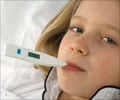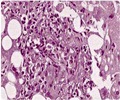A currently available yet underused vaccine against typhoid fever is highly effective in young children and protects unvaccinated neighbors of vaccines, finds a new study.
A currently available yet underused vaccine against typhoid fever is highly effective in young children and protects unvaccinated neighbors of vaccines, finds a new study.
The study, conducted by the International Vaccine Institute (IVI) in collaboration with the National Institute of Cholera and Enteric Diseases (NICED) in Kolkata, India, was published in the July 23 issue of the New England Journal of Medicine (NEJM). The IVI, based in Seoul, Korea, is a non-profit international organization devoted exclusively to development and deployment of new vaccines primarily for people in developing countries.Typhoid fever remains an important cause of illness and death in the developing world, killing an estimated 216,000 to 600,000 people annually. Multidrug-resistant Salmonella typhi has spread to many parts of the world, limiting the ability to treat typhoid fever with available antibiotics. Typhoid is both a waterborne and food-borne gastrointestinal infection, with incidence approaching one percent of the population annually in certain endemic areas. Experts say that in the absence of affordable programs to assure safe water and better sanitation, short and medium-term efforts need to be directed towards prevention through vaccines.
Safe and effective vaccines against typhoid fever exist, but they are used primarily for affluent travelers to developing countries, rather than for the poor residing in these countries, who account for almost all the global burden of typhoid morbidity and mortality. One of these vaccines, Vi polysaccharide, is ideally suited to use in developing countries because it is cheap (about $.50 per dose) and requires only a single dose.
Despite a recommendation by the World Health Organization for use of Vi vaccines in developing countries, its use has been limited, partly because of doubts about Vi's ability to protect pre-school age children. This age group is at exceptionally high risk in the poorest settings. There are also doubts about Vi's ability to confer "herd protection," or protection of unvaccinated residents living in highly vaccinated areas.
To address these uncertainties, the IVI in collaboration with NICED conducted a phase 4 cluster-randomized effectiveness trial, which randomized 80 geographic clusters of an urban Kolkata slum to either Vi or a control vaccine. Over two years of follow-up, the Vi group was shown to have 61 percent fewer episodes of typhoid than the control group. Protection of vaccinated children under five years of age by Vi was even higher, 80%. Interestingly, unvaccinated neighbors of Vi vaccinated persons had a 44 percent lower risk of typhoid, indicating that Vi vaccine conferred substantial herd protection. The overall level of protection among all residents of the Vi clusters, regardless of whether they were vaccinated was 57 percent. Since the coverage of residents of the Vi clusters was about 60%, this observation indicates that Vi vaccine prevented as many cases of typhoid in the total population as a vaccine that was nearly 100% protective in vaccinated persons.
"The protection for children under the age of five years is important because this age group has been shown to be at high risk for typhoid fever in many areas where the disease is endemic," said Dr. John Clemens, Director-General of the IVI and an international expert in vaccine evaluation. In a separate IVI study conducted in five Asian countries and supported by the Bill and Melinda Gates Foundation, children less than five years of age were found to have high rates of typhoid in Kolkata, India, Jakarta, Indonesia and Karachi, Pakistan, confirming that the disease is not limited to school-aged children and adults.
Advertisement
Meanwhile, in a separate vaccine development project, IVI laboratories have more than tripled the manufacturing yield of Vi polysaccharide, which is expected to further reduce the vaccine's production cost, thus making it more accessible for developing countries. The production technology for the high-yield Vi polysaccharide is being transferred to high-quality producers in developing countries.
Advertisement
ARU














